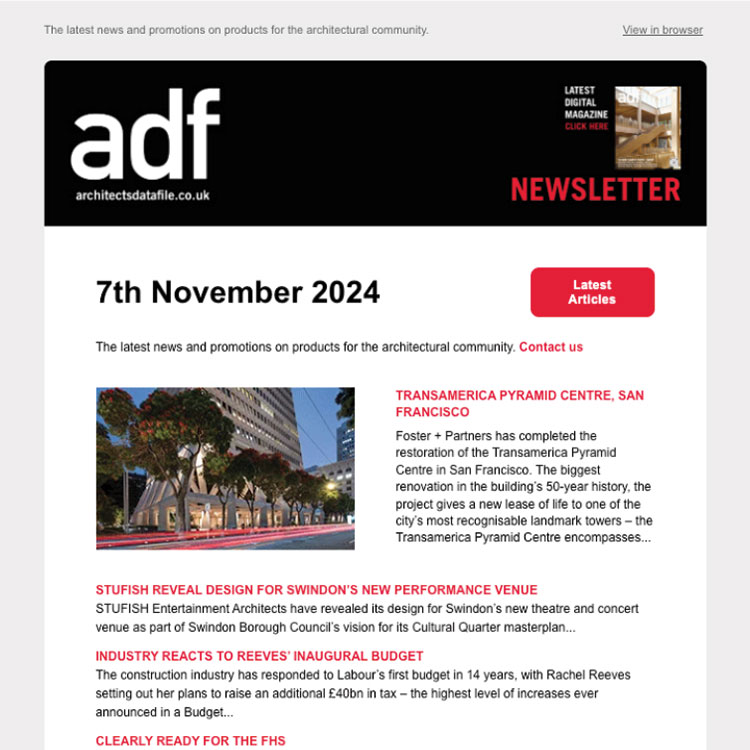ADF put readers’ questions on the specification of timber to Michael Allen, specification sales manager at Silva Timber (favourite building – St Peter’s Basilica, Rome).
The cutting of what type of timbers has a detrimental effect on climate change?
The cutting down of any timber affects climate change however there are misconceptions that cutting down trees only has a negative effect on the environment. Older trees that are cut down or left to die actually emit CO2 from the stored carbon, if these trees are harvested before this stage the CO2 will be stored within the timber for the life of the wood product.
By ensuring you purchase timber that has been sourced from responsibly managed forests you are guaranteeing that any harvested trees have been replaced with saplings. Young trees actually grow faster and therefore absorb more CO2, meaning that sustainably managed forests absorb more CO2 without causing or contributing to deforestation.
What are the recommended areas of use for treated timber?
When referring to treated timber, there are five main categories, which are defined under British Standard BS EN 335-1. These are as follows:
- UC 1 – Internal, dry (e.g. upper floor joists)
- UC 2 – Internal, risk of wetting (e.g. tile battens)
- UC 3 coated – Outdoors, coated, above ground (e.g. soffits/cladding)
- UC 3 uncoated – Outdoors, uncoated, above ground (e.g. cladding/fence rails)
- UC 4 – Direct soil or fresh water contact (e.g. fence posts).
The classes used are based on the potential threat to the timber from decay or insect attack in its application and lifespan. Some suppliers do not publicise what class the timber has been treated to, so always ask.
Can I be assured that contemporary timber cladding and shingles, properly installed, will have a sufficiently long enough life in situ to warrant their use as a building material in wet and damp conditions, IN relatively frost-free places such as Ireland?
Think of homes clad with cedar shingles along the West coast of Canada or the typical Scandinavian timber weatherboard buildings – right there you have examples of timber standing up to harsh weather conditions. Here in the UK there are numerous examples of timber cladding that have been around for decades. It is possible to extend the performance, appearance and service life of the wood by applying a finish at the outset.
How can I be sure that the timber specified comes from a sustainable source and/or managed forest?
With increased demand for sustainably sourced timber comes an increase in the amount of companies making claims they are providing sustainably sourced products. By using FSC paper with the logo on to print invoices, delivery notes etc, many companies can exploit the system by making it appear that their products are certified, when in fact it’s just the paper that is FSC certified.
There are ways to check that what you are purchasing is sustainably sourced. Firstly any company claiming to sell FSC or PEFC products will always have a certificate in place – you can check certificates on the FSC or PEFC database.
Secondly any products that claim to be FSC or PEFC certified must feature the logo or state the fact next to each relevant product on the delivery note and invoice.
It is possible for products to be sustainably sourced even without the FSC or PEFC certification. There are many other schemes that companies can be a part of – The EUTR (European Directive) and BM TRADA Forest Products Scheme. Companies selling sustainably sourced timber will always be happy to discuss their procurement policies.
The FSC list of certified suppliers http://www.fsc-uk.org/database.150.htm and the PEFC at www.pefc.org/find-certified/certified-certificates.
How long can timber be guaranteed protection in our climate?
Each timber species will have its own approximate lifespan, so it’s always worth checking with a supplier. There are timber buildings all over the globe that have stood the test of time for hundreds of years, the oldest existing wooden buildings are in China and date back to the mid Tang Dynasty (618-907).
Some of the most popular timber species for commercial applications include Western Red Cedar which can last over 60 years if installed correctly, Siberian Larch which can last over 50 years and ThermoWood, which has an expected life cycle of 30 years (60 years if finished and maintained). I would always recommend finishing your timber to not only enhance its beauty but also extend its life. There are specialist wood finishes on the market such as Sansin Enviro Stains which penetrate into the timber so will never peel, crack or blister and are long lasting and easy to maintain.
Why and when should I consider using timber for cladding?
Timber cladding has been used successfully on all types of buildings from homes to commercial offices, supermarkets and public spaces.
The possibilities are endless, there are many species available including Western Red Cedar, Siberian Larch, ThermoWood, Accoya and Oak.
Timber not only contributes to a building’s sustainable footprint but it also offers one of the most flexible options out there. Various different profiles and surface textures are available, each giving a subtly different look. Plus, using a finish you can select a colour that perfectly suits your project.
Timber Decking – when should I specify this and when shouldn’t I?
There is a common misconception that the applications for timber decking are limited however timber has been used in harbours, ski resorts and high traffic areas in some of the harshest environments on the planet.
Decking only becomes slippery when wet when it has been neglected and mould or algae has been allowed to grow on the surface. This can easily be prevented by applying a finish at the outset and periodic cleaning/maintenance.


